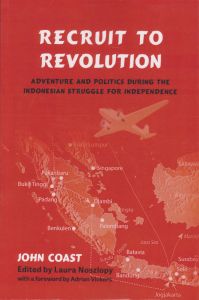
John Coast, Recruit to Revolution: Adventure and Politics during the Indonesian Struggle for Independence. Edited by Laura Noszlopy. Copenhagen: NIAS Press, 2015. xxvi + 336 pp.
The Republic of Indonesia won its independence by combining perjuangan (struggle) and diplomasi. Combat took place both on the ground inside Indonesia, and in the global arena through diplomatic pressure on the Netherlands. In other words, the Indonesian revolution was both a domestic and an international event.
John Coast, later to become a British impresario who worked with such artists as Luciano Pavarotti, Bob Dylan and Ravi Shankar, is not at first glance an obvious choice as chronicler of the Indonesian revolution’s diplomatic and military story. And yet, he embodies the revolution’s dual aspect well. Held as a Japanese prisoner in Thailand (then Siam) during the Second World War, he fell in love with Indonesian culture, and especially Balinese dance. Soon after Indonesia declared independence in 1945, Coast was a supporter. By 1949, when the Netherlands finally recognized Indonesian independence at the bargaining table, he was handling the Indonesian Republic delegation’s press relations. In the years between, he worked first as a British government information officer and then as an advisor to the Republic of Indonesia. In this latter role, Coast handled everything from running the Dutch blockade of the Republic’s trade by air, to trouble-shooting bad press that accused the Republic of opium smuggling.
Laura Noszlopy has made a valuable contribution by editing a re-issued and enhanced edition of Coast’s 1952 classic of his journey as pro-Indonesia partisan, Recruit to Revolution. This book follows her editing of Coast’s earlier account of his days as a Japanese prisoner-of-war, Railroad of Death. Originally written for a mass audience, Coast’s work will now interest scholars of Indonesian history. The tale through his eyes is one of adventure, personal political journey, and one man’s experience of the Indonesian revolution. It both entertains and sheds light on less-studied aspects of that revolution. Coast’s key roles were to establish an air route around the Dutch blockade, flying in and out people and supplies between Siam and the Republic’s capital, Jogjakarta (now Yogyakarta). He positions himself as both insider and outsider, as confidante of Indonesian leaders and as independent observer of their own and their new country’s foibles. Fascinating character sketches of President Sukarno, vice-president Mohammad Hatta, and such leading figures as Sutan Sjahrir, Amir Sjarifuddin, and Haji Agus Salim offer useful additions to the narrative.
Although Jogjakarta features, it does not always come across as a city that Coast enjoyed – still less his Sumatra stopovers in Bukittinggi and elsewhere. Coast’s portrait of Indonesian leaders and their Republic mixes admiration and advocacy for their cause with criticism. He was based in Siam for most of the period in question, and the book thus features a series of looping arcs from Siam to Jogjakarta and back to Siam (three times), from Siam to Britain (where he travelled, twice, on missions for the Republic), and finally from Siam to Jakarta, capital of the new independent state established in 1949. So although the material on the Republic’s struggle is useful, this book may make its strongest contribution to historical study of the Indonesian revolution by its examination of the far-flung (if poverty-stricken) overseas diplomatic network of unofficial Indonesian embassies and offices outside the country. These both funneled cash to the Republic and carried its message, with impressive success, to global audiences. If diplomasi and struggle were both needed, Coast is one of the minority of writers who tells us things about diplomasi’s contribution to Indonesian independence.
In this new edition, Noszlopy has added much. The text is unchanged, but footnotes explain references to individuals and contexts that a 1952 reader might know well, but which may leave a 2017 reader in the dark. A postscript tells the tale of what happened after the book’s story finishes, detailing the futures of the major protagonists. Three historical documents – two reports by Coast, a British Foreign Office dispatch, and a radio broadcast by Coast, round off the book. An insightful introduction by Noszlopy puts it all in context. The book, in sum, is a model of how to edit a historical classic by bringing it back into the historiography, adding value, and respecting the original text.
Originally published as David Webster (2018) Recruit to Revolution: Adventure and Politics during the Indonesian Struggle for Independence, History: Reviews of New Books, 46:2, 52-53, DOI: 10.1080/03612759.2018.1412762. This version is the author pre-print.